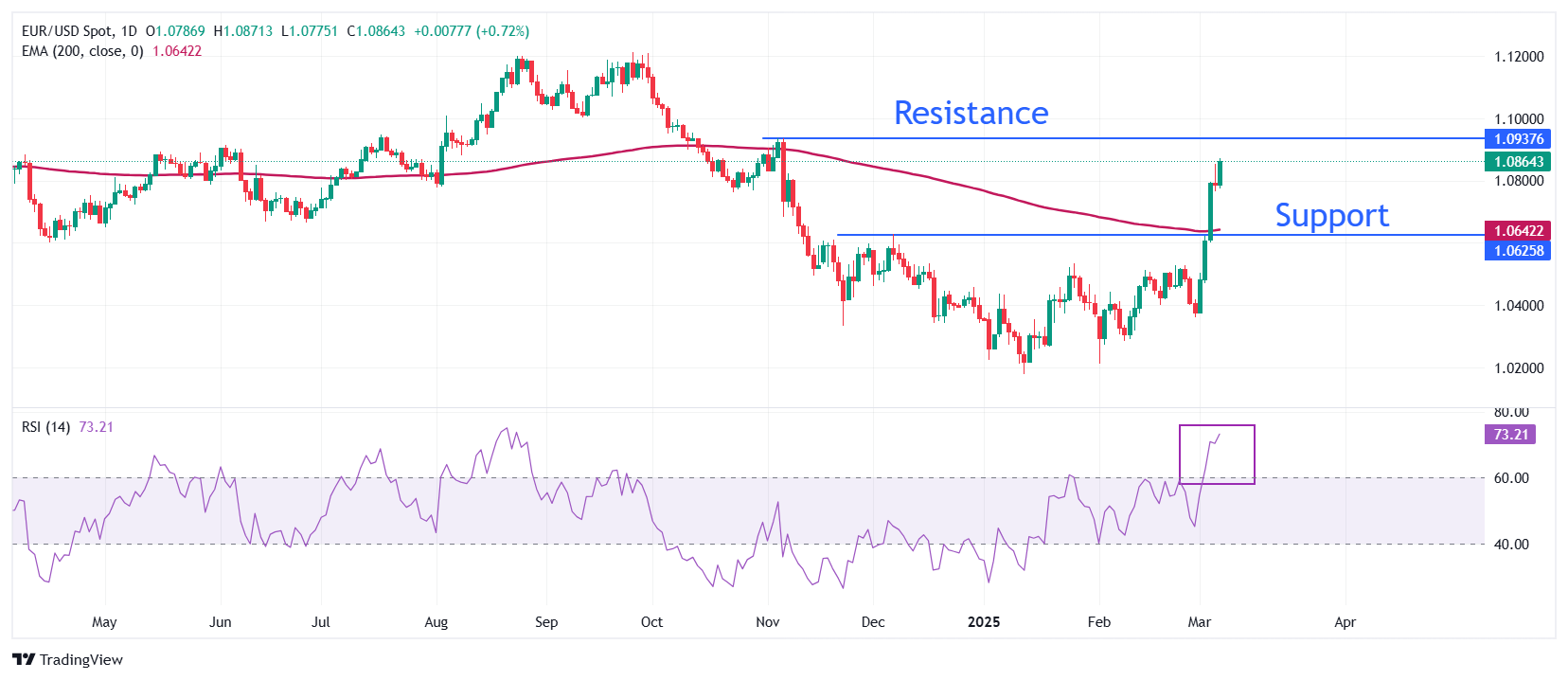- EUR/USD rises above 1.0850 as the US Dollar weakens ahead of February’s NFP release.
- President Trump grants additional exemptions on imports from Canada and Mexico.
- German debt reforms prompt traders to scale back ECB dovish expectations.
EUR/USD surged above 1.0850 during Friday’s European session, reaching a four-month high as the US Dollar (USD) continues to decline. The pair gains strength ahead of the US Nonfarm Payrolls (NFP) data for February, set for release at 13:30 GMT. Meanwhile, the US Dollar Index (DXY), which measures the Greenback’s value against six major currencies, extends its losing streak for the fifth consecutive day, dropping to a four-month low around 103.60.
The US Dollar remains under pressure as investor concerns over the US economic outlook grow, fueled by uncertainty surrounding President Donald Trump’s tariff policies. Markets anticipate that higher tariffs will burden US importers, who may pass on the costs to consumers, ultimately weakening domestic demand.
On Thursday, Trump announced tariff exemptions for several products under the US-Mexico-Canada Agreement (USMCA), effective until April 2—the same day he is expected to introduce reciprocal tariffs. While the US imposed 25% tariffs on Canada and Mexico earlier this week, the administration granted a one-month exemption on automobiles following discussions with major US automakers.
The upcoming NFP report is projected to show a job gain of 160K in February, an increase from January’s 143K. The unemployment rate is expected to hold steady at 4%, while Average Hourly Earnings—a key wage growth indicator—are forecasted to rise 4.1% year-on-year. However, monthly wage growth is estimated to slow to 0.3%, down from 0.5% in January. The labor market report will be a key factor in shaping expectations for the Federal Reserve’s (Fed) monetary policy.
Market Movers: EUR/USD Strengthens on ECB Policy Reassessment and German Debt Reforms
- The Euro (EUR) continues to outperform as traders scale back expectations of further European Central Bank (ECB) rate cuts due to recent German debt reforms. Germany’s confirmation of a €500 billion infrastructure fund and reforms to its “debt brake” are seen as inflationary, potentially prompting the ECB to slow its monetary easing cycle.
- Despite these developments, ECB President Christine Lagarde refrained from commenting on the impact of German debt reforms during Thursday’s press conference, stating that increased defense and infrastructure spending remains a "work in progress" and requires further evaluation.
- Traders have adjusted their expectations for ECB policy, now anticipating a potential pause in rate cuts by April after five consecutive reductions. Previously, markets had priced in two more rate cuts by summer. Lagarde did not outline a specific rate-cut plan but emphasized the ECB’s “data-dependent” approach, making decisions on a “meeting-by-meeting” basis.
- While the ECB lowered the Deposit Facility Rate by 25 basis points (bps) to 2.5% as expected, Lagarde warned that economic risks remain tilted to the downside, with Trump’s trade policies posing further threats to the Eurozone economy.
- The next key event for the Euro will be discussions in Germany’s lower house of parliament (Bundestag) on March 13 regarding increased defense and infrastructure spending, followed by a vote on debt reforms on March 18, according to Reuters.
Technical Analysis: EUR/USD Maintains Bullish Momentum

EUR/USD has rallied past 1.0850 following a breakout above the December 6 high of 1.0630 earlier this week. The pair remains bullish in the long term, holding above the 200-day Exponential Moving Average (EMA) near 1.0640.
- The 14-day Relative Strength Index (RSI) has climbed above 70.00, signaling strong bullish momentum.
- Support Levels: The December 6 high at 1.0630 serves as a key support zone.
- Resistance Levels: The November 6 high at 1.0937 and the psychological barrier at 1.1000 are the next key hurdles for Euro bulls.
As long as EUR/USD stays above key support levels, the bullish trend is expected to continue.





